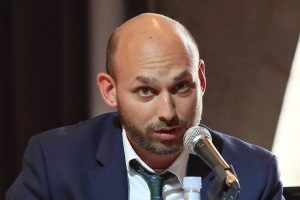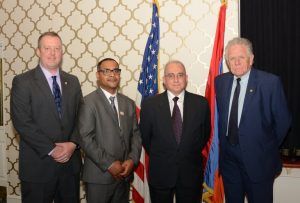HAGOP PANOSSIAN: “Armenia has to develop a new strategy for the development of science”

President of California’s ARPA Institute, Professor of University of California-Northridge Hagop Panossian is in Armenia.
The results of APRA Institute’s annual Innovation Competition were summed up during an event held at Yerevan State University on October 18. Eight students from Yerevan State University, the State Engineering University of Armenia, the Armenian State Agrarian University and the European Regional Educational Academy had applied to participate in the competition.
On October 24, RA Minister of Diaspora Hranush Hakobyan received President of the Institute Hagop Panossian. The sides discussed issues on cooperation and the issues related to reciprocal ties between students.
Representative of the RA Ministry of Diaspora Lilit Damiryan sat down for an interview with President of ARPA Institute Hagop Panossian.
Lilit Damiryan: Mr. Panossian, please tell us where you were born, where you studied and how you settled in the United States.
Hagop Panossian: I was born in Aynchar and received my primary and secondary education at the Secondary Evangelical School in Aynchar. I graduated from the American University in Beirut and moved to the United States where I obtained my MA in Engineering from the University of Southern California and later my PhD in Engineering from UCLA.
Lilit Damiryan: In 1983, you established the Association of Architects and Scientists, and in 1992, you founded the ARPA Institute and have been directing the Institute ever since.
You are also author of 75 scientific articles, have projecmed the management of a complicated rocket engine that was experimented and will be used in new systems of rockets and airplanes.
How do you manage to combine your academic activities with large-scale organizational activities, including your charities for science and technology in Armenia?
H. P.: Just the thought of supporting the development of science in Armenia and the homeland’s development gives us Diaspora Armenians strength. Our main objective is to help the youth.
I would like for Armenian youth to feel that the country is theirs and to care for the land, the people’s health, the conservation of nature and Armenia’s prosperity in all spheres. The academics and human attributes of conscious youth standing up for their rights instill hope in us.
Our projects are aimed at supporting those youth, Armenian scientific thought so that Armenian youth keep up with the scientists of developed countries and help overcome the challenges facing the world.
We encourage and attach importance to all innovations presented by Armenian youth, if they can justify that they are not duplicating a previous project.
But I regret that the RA Ministry of Diaspora is the only Armenian government agency that supports and collaborates with us.
Lilit Damiryan: Mr. Panossian, how long has ARPA been around? What are its goals and projects?
H. P.: ARPA Institute is a non-profit organization founded in Los Angeles in 1992 by a group of Armenian American scientists. The main purpose of the organization is to foster cooperation between Armenia and the United States in education, economy, politics, healthcare and technologies.
ARPA helps young scientific workers of Armenia conduct their research through state-of-the-art technologies and contribute to the country’s economic development with their new products, inventions and innovations.
Unfortunately, only 8 students from Yerevan State University, the State Engineering University of Armenia, the Armenian State Agrarian University and the European Regional Educational Academy applied for this year’s Innovation Competition. Compared to previous years, there was a lack of participants this year.
All the participants received diplomas. The contest committee decided not to give the 1st place to anyone, and the students and their supervisors who won 2nd and 4th places received financial awards in the amount of 400-1,000 dollars.
Lilit Damiryan: In addition to the annual Innovation Competition, which has only been around for the past six years, ARPA has also carried out several other projects in Armenia since 1992. Could you please tell us about them?
H. P.: ARPA studies different fields of science and technology in Armenia and creates projects based on our experts’ conclusions.
In 1992, we organized the first conference for energy experts in Armenia with 29 experts from the Diaspora.
In Los Angeles we organize distance learning seminars through which we hold professional debates on important issues concerning Armenia and all Armenians. We hold annual distance lectures that are aimed at discussing the important problems related to Armenians in Armenia. Experts from different states of the United States share their knowledge and information about innovations in science and particularly engineering with students and professors of Armenia’s universities. The listeners ask their questions and receive answers.
I must also mention that our “Healthy Lifestyle and Lifestyle” educational project was introduced in Armenia’s public schools seven years ago.
Lilit Damiryan: What kinds of projects do you implement for the preservation of Armenian culture? To what extent are your projects supported in Armenia?
H. P.: In addition to several projects, I attach great importance to the e-archeology project targeted at the digitization of the entire archives and all the samples of museums. One of our partners from Damascus created the project for Syria, but it wasn’t implemented in Syria and now our partner is willing to give that project to Armenia for free.
The e-archeology project will provide the opportunity to digitize all historical-archaeological (in museums and other sites) objects and monuments located in the Republic of Armenia.
The California-based Analysis Research and Planning for Armenia (ARPA) has launched a fundraiser to obtain a DNA-secvensor for Armenia.
The DNA-secvensor is a scientific device applied to automatically determine the succession of DNA.
The goal of the project is to obtain a state-of-the-art DNA-secvensor for Armenia and train specialists. This will provide the opportunity to identify thousands of genetic aspects of diseases. We anticipate the Armenian government’s support to carry out this DNA project, which is very important for the development of economy, science and research in Armenia.
Our Institute’s high-quality experts work on a voluntary basis. We study different fields of science and technology in Armenia and create projects. I can bring up the example of the state-of-the-art center for blood transfusion and research established at Erebuni Hospital in Armenia.
But ARPA can’t accomplish its goals with just the support from the Armenian government since the essence of our activities is to provide Armenia with professional services.
Lilit Damiryan: How do you see the future of science in Armenia? Is there a specific government strategy for the development of science? Are you working with the National Academy of Sciences and structures coordinating the sphere of science?
H. P.: The field of science is in a state of crisis in Armenia.
Students and youth are in the focus of our efforts since the future of Armenia is the new generation, which must lead the country towards development with a healthy mindset and as conscientious citizens of the Republic of Armenia.
There is a lot to do in the field, even though there is some progress being made. For instance, the new laboratory at the engineering university provides students with the opportunity to test their theoretical knowledge in various branches. Some institutes of the NAS are also carrying out some activities and are participating in global conferences.
If Armenia doesn’t create new products, it can’t go very far in a rapidly changing world. To become competitive, the country has to be recognized with its products. There is quite a lot of progress in the IT field, but you can’t develop the economy with just the IT field.
Economy can be developed through any branch of science. For instance, there are some innovations in land cultivation, and the same goes for the mining industry. Pharmaceutics must play a special role in Armenia since it’s possible to have innovations with minimum resources.
Armenia has to develop a state strategy on the directions for the development of science in Armenia and, if necessary, it should invite experts from different countries.
I believe in the future of Armenia that will be developed with the help of science.
I’m certain that innovators will be able to help Armenia develop its economy and become competitive quickly.
LIlit Damiryan: Mr. Panossian, I thank you for your pro-national activities. I wish you success in implementing all your projects for the development of science in Armenia.
Interview by Lilit Damiryan




 Արևելահայերեն
Արևելահայերեն Արևմտահայերեն
Արևմտահայերեն Русский
Русский






